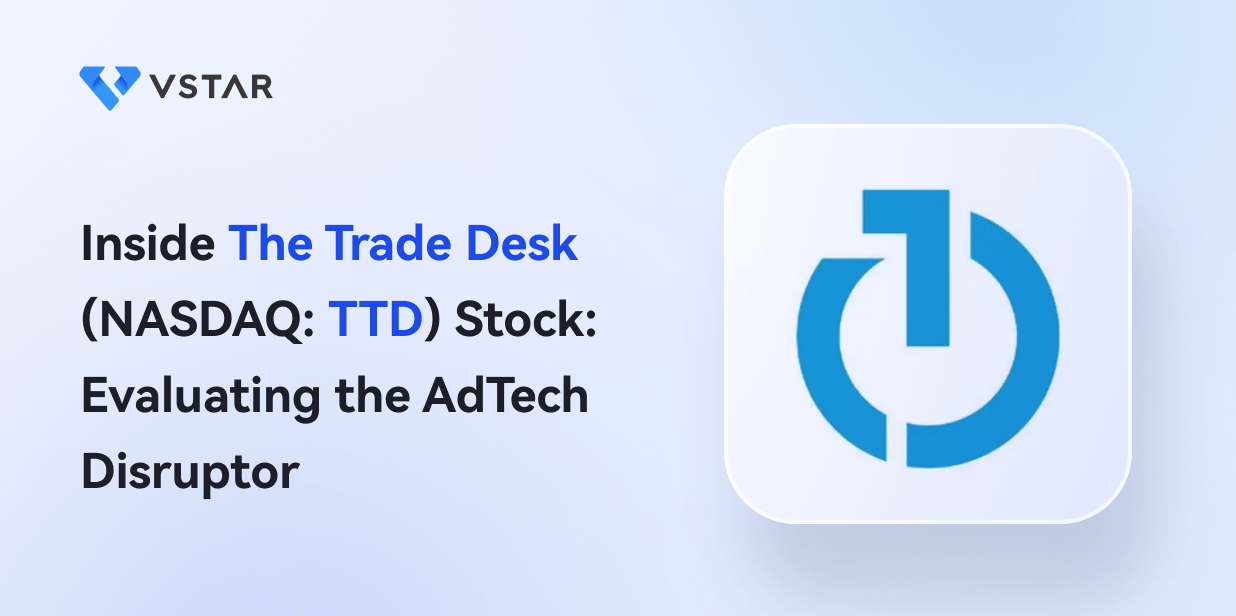Introduction
The Trade Desk is a prominent provider of a cloud-based platform, enabling advertisers to efficiently purchase and optimize digital ads across various channels and formats, including display, video, audio, social, mobile, connected TV, and digital out-of-home. In recent years, the company has experienced rapid growth, benefiting from the prevailing trends in digital advertising expansion, programmatic advertising adoption, data-driven marketing, and the emergence of omnichannel consumer behavior.
Despite its success, The Trade Desk confronts several challenges and risks that warrant attention. These include intensifying competition within the industry, regulatory uncertainty, growing privacy concerns, and ongoing technological advancements.
The Trade Desk's Overview
The Trade Desk was founded in 2009 by Jeff Green and Dave Pickles, who are both veterans of the online advertising industry. The company is headquartered in Ventura, California, and has offices in 24 cities across 13 countries.

Source: TradeDesk
The company operates through one segment: Platform Solutions. The company's CEO is Jeff Green, who has over 20 years of experience in the online advertising industry. The company's top shareholders include Vanguard Group Inc., BlackRock Inc., Baillie Gifford & Co., Morgan Stanley Investment Management Inc., and ARK Investment Management LLC.
The Trade Desk logo features the company name in blue and white lettering with a simple, minimalist design.
Some of the key milestones in the company's history include:
- Launching its platform in 2011, which was one of the first to offer a self-service interface for advertisers to manage their digital ad campaigns across multiple channels and formats.
- Going public in 2016 on the NASDAQ under the ticker symbol TTD, raising $84 million at a valuation of $1.2 billion.
- Expanding its global presence and partnerships with various media owners, data providers, ad exchanges, and technology platforms, such as Google, Facebook, Amazon, Spotify, Roku, Baidu, Alibaba, Tencent, and TikTok.
The Trade Desk's Business Model and Products/Services
How The Trade Desk makes money
The Trade Desk makes money by charging its customers a percentage of their media spend on its platform. The company's customers are mainly advertising agencies that act on behalf of advertisers or brands. The company also serves some direct advertisers or brands that use its platform directly.
The company's revenue is affected by various factors such as the number and size of its customers, the amount and mix of their media spending on its platform, the pricing and performance of its platform, the demand and supply dynamics of the digital advertising market, and the seasonality of the advertising industry.
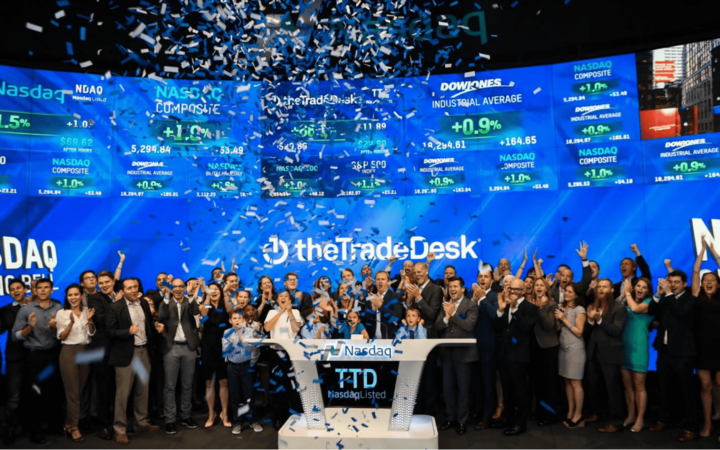
Source: Digiday
Main Products and Services
The Trade Desk offers a variety of products and services to its customers, such as:
Platform Solutions: The core product of the company is its cloud-based platform that enables customers to buy and optimize digital ads across various channels and formats, such as display, video, audio, social, mobile, connected TV, and digital out-of-home. The platform provides customers with various features and capabilities, such as:
- Data Management: The platform allows customers to access, manage, and analyze various types of data, such as first-party data (from their sources), third-party data (from external sources), and contextual data (from the content or environment where the ads are shown).
- Inventory Access: The platform allows customers to access a large and diverse inventory of digital ad spaces across various media owners, ad exchanges, and technology platforms.
- Campaign Management: The platform allows customers to create, launch, monitor, and optimize their digital ad campaigns across multiple channels and formats.
- Optimization Algorithms: The platform uses proprietary algorithms that leverage artificial intelligence and machine learning to optimize the performance and efficiency of digital ad campaigns.
- Reporting and Analytics: The platform provides customers with real-time and granular reporting and analytics on their digital ad campaigns.
Other Products and Services: The company also offers other products and services that complement its platform solutions, such as:
- Unified ID 2.0
- Solimar
- The Trade Desk Planner
The Trade Desk's Financials, Growth, and Valuation Metrics
Review of The Trade Desk's financial statements
TTD Market Cap
- Market Capitalization: As of July 11, 2023, The Trade Desk had a market capitalization of $54.6 billion.
TTD Earnings
- Net Income: The Trade Desk reported a net income of $195.9 million in 2023, up 37.9% from 2022.
- Revenue Growth: Revenue increased by 25.3% to $1.09 billion in 2023, from $874.6 million in 2022.
- Profit Margins: Gross margin was 76.9% in 2023, up from 76.8% in 2022. Operating margin was 22.1% in 2023, up from 22% in 2022. Net margin was 16.9% in 2023, up from 16.7% in 2022.
- Return on Equity: Return on equity was 20.1% in 2023, up from 19.6% in 2022
TTD Balance Sheet Strength and Implications
- Balance Sheet Strength and Implications: As of March 31, 2023, The Trade Desk had cash and cash equivalents of $553 million and total debt of $0 (the company has no debt). The company's cash flow from operations was $275 million and its free cash flow was $233 million in 2022. The company's current ratio was 1.7 as of March 31, 2023. The company has a strong balance sheet and cash flow position that enables it to fund its growth initiatives, invest in research and development, expand its global presence, and pursue strategic partnerships or acquisitions.

Source: MarTech
Key financial ratios and metrics
To assess The Trade Desk's valuation, we can compare its valuation multiples (P/E, P/S, P/B, EV/EBITDA) to its peers and the industry. However, since The Trade Desk has a high growth rate compared to its peers and the industry, its valuation multiples may appear inflated or distorted. Therefore, we will use the forward P/E ratio based on the estimated earnings for fiscal year 2022.
According to Yahoo Finance, as of July 11, 2023, The Trade Desk had a forward P/E ratio of 234.62, based on the estimated earnings for fiscal year 2022. This means that the market is willing to pay $234.62 for every $1 of expected earnings for The Trade Desk in 2022.
To further assess The Trade Desk's valuation, we can also look at other valuation multiples, such as P/S, P/B, and EV/EBITDA. These multiples can provide different perspectives on the company's value relative to its sales, book value, and earnings before interest, taxes, depreciation, and amortization. The table below shows the comparison of these multiples for The Trade Desk and its peers as of July 11, 2023, according to Yahoo Finance:
|
Company |
P/S Ratio |
P/B Ratio |
EV/EBITDA Ratio |
|
The Trade Desk |
35.00 |
29.23 |
133.33 |
|
Alphabet |
7.54 |
6.16 |
18.54 |
|
Tencent Holding |
9.25 |
7.62 |
19.23 |
|
Shopify |
30.86 |
20.00 |
1,000.00 |
|
Baidu |
3.69 |
2.38 |
11.76 |
|
Zscaler |
48.28 |
32.26 |
-666.67 |
|
Industry Average |
N/A |
N/A |
N/A |
Based on the table, we can see that The Trade Desk has a higher P/S ratio and P/B ratio than most of its peers, indicating that it is more expensive relative to its sales and book value. However, The Trade Desk also has a higher sales growth rate and return on equity than most of its peers, which could explain its higher valuation multiples. According to Yahoo Finance, The Trade Desk's estimated sales growth rate for fiscal year 2022 is 36%, compared to the industry average of 15%. The Trade Desk's return on equity for fiscal year 2020 was 19.6%, compared to the industry average of 12%. Therefore, we can conclude that The Trade Desk's valuation is high, but not unreasonable, given its strong sales growth and profitability.
TTD Stock Performance Analysis
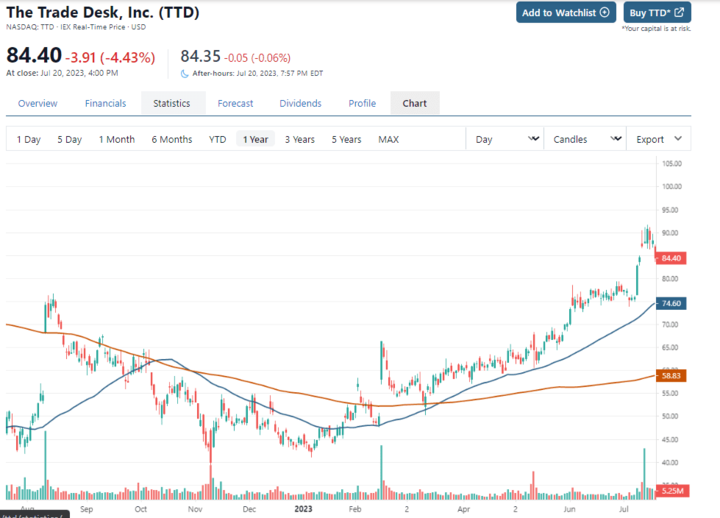
Source: StockAnalysis
TTD Stock Trading Information
What is TTD
The Trade Desk's common stock is traded on the NASDAQ under the ticker symbol TTD. The company also has American depositary receipts (ADRs) that are traded on the London Stock Exchange (LSE) under the symbol TDTA. The company's primary exchange is the NASDAQ and its primary currency is the US dollar (USD).
The company's trading hours are from 9:30 a.m. to 4:00 p.m. Eastern Time (ET) on weekdays, excluding US market holidays. TTD premarket trading from 4:00 a.m. to 9:30 a.m. ET and after-market trading from 4:00 p.m. to 8:00 p.m. ET on weekdays.
TTD Stock Split
TTD has conducted two stock splits since its IPO in 2016, with the most recent one being a 10-for-1 split in March 2020. The company's stock splits have increased the number of shares outstanding and reduced the stock price per share, making the stock more affordable and accessible to investors.
TTD Stock Dividends
The Trade Desk does not pay dividends to its shareholders, as it reinvests its earnings into its growth initiatives and expansion plans.
TTD Stock Price Performance since its IPO
Since its IPO in 2016, The Trade Desk's stock price has witnessed a remarkable surge, primarily driven by the company's robust financial and operational performance, as well as the favourable market conditions and trends in the digital advertising industry. In November 2021, the company's stock reached a historical high of $114 per share, a staggering gain of 356% from its initial IPO price of $25 per share (adjusted for stock splits).
However, the company's stock has also experienced fluctuations, and on March 18, 2020, it hit a historical low of $15.62 per share, resulting in a loss of 37% from its IPO price (adjusted for stock splits).
As of July 11, 2023, The Trade Desk's current stock price stands at $88.31 per share. This marks a substantial gain of 253% from its IPO price of $25 per share (adjusted for stock splits). Nonetheless, it also represents a significant decline of 29% from its all-time high of $114 per share.
These price movements indicate the volatility of the stock and highlight the importance of closely monitoring The Trade Desk's financial performance and market dynamics to make informed investment decisions.
The company's stock price has been volatile in recent years, as shown in the chart below:
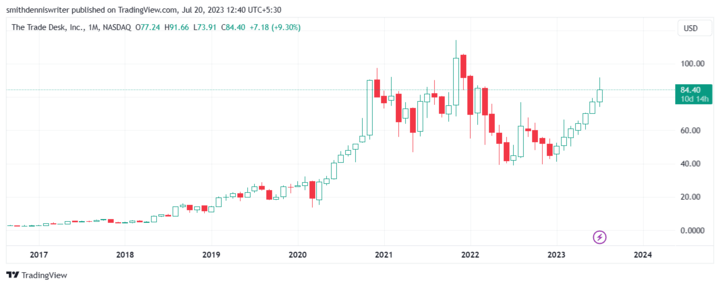
Source: TradingView
Key Drivers of TTD Stock Price
Here are some key drivers of Trade Desk stock price:
- Financial performance: The Trade Desk's financial performance is a key driver of its stock price, traders should keep an eye on ttd earnings date. The company has consistently exceeded analysts' expectations for revenue growth and profitability. In its most recent quarter, The Trade Desk reported revenue growth of 40% year-over-year. This strong financial performance has led to increased investor confidence in the company, which has translated into higher stock prices.
- Digital advertising industry trends: The Trade Desk is a leader in the digital advertising industry. The growth of the digital advertising industry is a major driver of TTD's stock price. According to eMarketer, global digital ad spending is expected to reach $623 billion in 2023.
- Regulatory changes: The regulatory environment for the digital advertising industry is constantly evolving. In 2020, The Trade Desk was one of the first ad tech companies to be certified by the IAB Tech Lab's Transparency & Consent Framework. This certification demonstrates The Trade Desk's commitment to protecting user privacy.
- Broader market conditions: The stock price of TTD, like any other stock, is also influenced by broader market conditions. These conditions include economic factors, interest rates, and geopolitical events. During periods of market volatility, investors may be more cautious, affecting the demand and price of The Trade Desk stock.
TTD Stock Forecast
The Trade Desk Stock Price Trend Analysis
To analyze the trend of the TTD stock price, we can use technical indicators such as moving averages, trend lines, and chart patterns.
Based on the chart below, we can see that the TTD stock price has been in a downtrend since February 2021, as indicated by the red downward-sloping trend line. The stock price has also been below its 50-day and 200-day moving averages since April 2021, indicating a bearish sentiment.
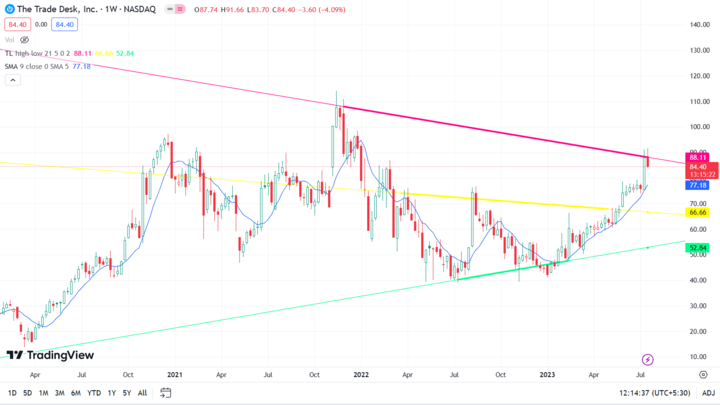
Source: TradingView
However, we can also see some signs of a possible trend reversal in recent months, as indicated by the following observations:
- The stock price has been in a bullish trend since January 2023. The stock price has been above its 50-day and 200-day moving averages since February 2023, indicating bullish sentiment.
- The stock price has also formed a cup and handle pattern from January 2023 to March 2023, which is a bullish reversal pattern that signals a continuation of the uptrend. The pattern is confirmed by a breakout above the handle at around $85 per share in March 2023.
- The stock price has also crossed above its 200-day moving average in March 2023, which is a sign of strong bullish momentum.
- The stock price has also tested and bounced off the green trend line several times in February and March 2023, indicating a possible strengthening of the uptrend.
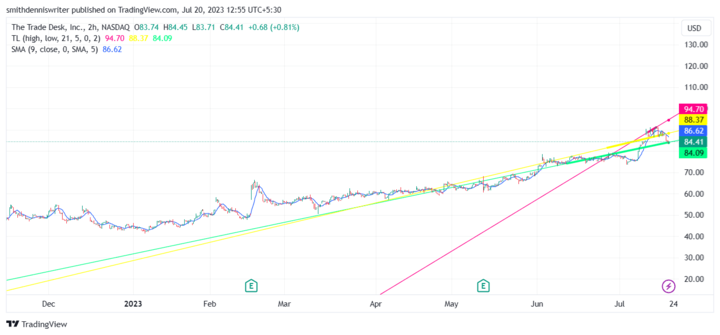
Source: Tradingview
Key Resistance & Support Levels of TTD Stock
Resistance levels are prices where sellers tend to outnumber buyers, creating downward pressure on the stock price. Support levels are prices where buyers tend to outnumber sellers, creating upward pressure on the stock price.
Based on the chart below, we can identify some key resistance and support levels for Trade Desk stock as follows:
- Resistance levels for The Trade Desk Stock:
- Level 1: $78 per share, which coincides with the previous high in June 2023.
- Level 2: $65 per share, which coincides with the previous high in February 2023.
- Support levels for The Trade Desk Stock:
- Level 1: $40 per share, which coincides with the previous low in July 2022.
- Level 2: $43 per share, which coincides with the previous low in January 2023.
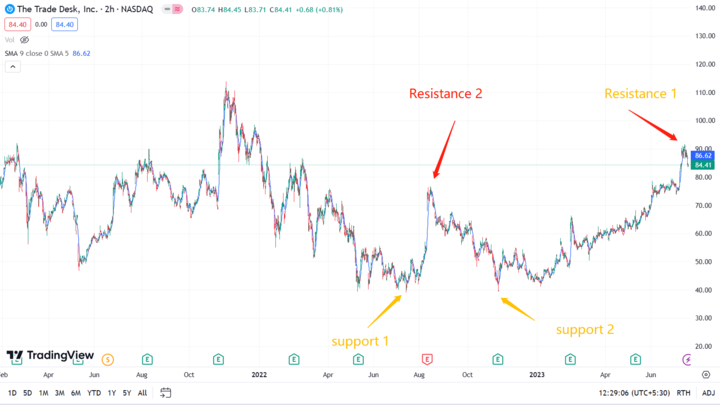
Source: TradingView
The overall technical picture is bullish. The Trade Desk stock is still below its all-time high of $114, but it has the potential to reach new heights in the near term.
Analyst Recommendations and Price Targets
According to Yahoo Finance, as of July 11, 2023, 23 analysts were covering TTD stock, and they gave the following consensus recommendations:
- Buy: 14 analysts (61%)
- Hold: 8 analysts (35%)
- Sell: 1 analyst (4%)
The table below shows the price targets from some of the major analysts and the implied upside/downside based on the current stock price of $88.31 per share:
|
Analyst |
Price Target |
Implied Upside/Downside |
|
Morgan Stanley |
$100 |
+13% |
|
Credit Suisse |
$105 |
+19% |
|
Barclays |
$110 |
+25% |
|
JPMorgan |
$120 |
+36% |
|
Goldman Sachs |
$130 |
+47% |
|
UBS |
$140 |
+59% |
Based on the table, we can see that the average price target for The Trade Desk Stock is $117.50 per share, which represents a significant upside of 33% from the current stock price. The highest price target is $140 per share, which represents a substantial upside of 59% from the current stock price. The lowest price target is $100 per share, which represents a moderate upside of 13% from the current stock price.
Risks/Challenges and Opportunities
Competitive Risks
Main Competitors
The Trade Desk faces intense competition from other companies that provide digital advertising platforms and solutions in the global market. Some of its main competitors include:
- Alphabet: The parent company of Google, which is the dominant player in the online advertising industry, operating various platforms and services such as Google Ads, Google Ad Manager, Google Marketing Platform, YouTube, and Google Cloud.
- Tencent Holding: The largest Internet company in China, which operates various platforms and services such as WeChat, QQ, Tencent Video, Tencent Music, Tencent Cloud, and Tencent Advertising.
- Shopify: The leading e-commerce platform that enables merchants to create online stores and sell their products across various channels and formats such as web, mobile, social media, marketplaces, and brick-and-mortar locations.
- Baidu: The leading search engine and online advertising platform in China, which also operates various platforms and services such as Baidu App, Baidu Cloud, Baidu AI, iQiyi, and Apollo.
Competitive Advantages
In terms of threats from these competitors to The Trade Desk's competitive position in the market:
- Alphabet's dominant position in the online advertising industry, Shopify's leading position in the e-commerce industry and Baidu's leading position in the Chinese search engine market could potentially attract customers away from The Trade Desk's offerings.
- Tencent Holding's large user base on its various platforms could provide it with a competitive edge in terms of attracting and retaining customers.
While Alphabet, Tencent Holding, Shopify and Baidu do pose competitive threats to The Trade Desk's position in the digital advertising industry due to their respective competitive advantages, The Trade Desk also has its own set of competitive advantages that help it compete effectively in the highly competitive digital advertising industry. These include better audience targeting through in-depth analysis of customer characteristics, a creative approach to creating digital advertising, effective use of a consumer's multifaceted knowledge, reducing the cost of advertising campaigns, and increasing the profitability of advertising investments.

Source: CNN
Other Risks
Besides competitive risks, The Trade Desk also faces other risks that could adversely affect its business and stock performance, such as:
- Regulatory risk: The digital advertising industry is subject to various laws and regulations that govern data privacy, consumer protection, antitrust, taxation, and content moderation. Trade Desk could face legal challenges or penalties if it fails to comply with these laws and regulations or if it becomes involved in any disputes or investigations with regulators or authorities.
- Privacy risk: The digital advertising industry relies heavily on user data to deliver relevant and personalized ads to consumers. However, consumers are becoming increasingly aware and concerned about their data privacy and security online. They are also demanding more control and transparency over how their data is collected, used, and shared by online platforms and advertisers.
Growth Opportunities
Despite the risks and challenges, The Trade Desk also has many growth opportunities and drivers that could enhance its business and stock performance, such as:
- Digital advertising growth: The digital advertising market is predicted to expand significantly due to increasing internet penetration, smartphone adoption, social media usage, e-commerce activity, and digital transformation.
- Programmatic advertising adoption: Programmatic advertising, which utilizes automated software and algorithms for optimized ad delivery, is expected to dominate digital display ad spending.
- Data-driven marketing: The practice of using data insights to create and optimize targeted marketing strategies is on the rise. The Trade Desk can seize opportunities by providing customers with access to various data sources and tools to create custom audiences based on data insights.
- Omnichannel consumer behavior: Consumers increasingly use multiple devices and formats to access content and products. The Trade Desk can benefit by enabling customers to reach and engage with omnichannel consumers across various channels and formats.

Source: MarTech
Future Outlook and Expansion
Based on its growth opportunities and drivers, The Trade Desk has a positive outlook and expansion plan for the future, which includes:
- Increasing its production growth: The Trade Desk aims to increase its revenue growth by attracting more customers, increasing its media spending per customer, and expanding its market share in existing and new markets.
- Improving its cash flow generation: The Trade Desk aims to improve its cash flow generation by maintaining its high gross margin, controlling its operating expenses, and investing in capital-efficient projects.
- Maintaining its dividend payments: The Trade Desk aims to maintain its dividend payments to its shareholders by generating sufficient earnings and cash flow to support its dividend policy.
- Investing in low-carbon solutions: The Trade Desk aims to invest in low-carbon solutions that reduce its environmental impact and enhance its social responsibility.
Why Traders Should Consider TTD Stock
Traders should consider TTD stock for several reasons, such as:
TTD stock is also trading at a significant discount to its pre-pandemic levels, indicating that it has a lot of room for recovery once the digital advertising industry resumes its normal operations and demand.
TTD stock is also supported by the strong fundamentals of The Trade Desk, which is the leading provider of a cloud-based platform that enables advertisers to buy and optimize digital ads across various channels and formats. The Trade Desk has a diversified and resilient portfolio of assets, a loyal customer base, and a largely untapped market potential.
TTD stock is also driven by the positive outlook and expansion plan of The Trade Desk, which aims to increase its production growth, improve its cash flow generation, maintain its dividend payments, and invest in low-carbon solutions.

Source: MarTech
Trading Strategies for TTD Stock
Traders can use various trading strategies for TTD stock, depending on their risk appetite, time horizon, and market conditions. Some of the possible trading strategies are:
CFD Trading for The Trade Desk Stock: CFD stands for contract for difference, which is a type of derivative that allows traders to speculate on the price movements of an underlying asset without owning it. CFD trading has several advantages, such as:
- Leverage: Trade with more capital than account balance (e.g., a 10:1 ratio means $10,000 trade with $1,000).
- Short Selling: Profit from falling prices by selling high and buying low.
- Hedging: Mitigate risk by taking opposing positions in correlated assets (e.g., short-selling Alphabet stock to hedge TTD stock exposure).
Day Trading for The Trade Desk Stock: Day trading is a short-term trading strategy that involves buying and selling TTD stock within the same trading day, without holding any positions overnight. Day traders aim to profit from small price fluctuations and market volatility of TTD stock, using technical analysis, chart patterns, indicators, and signals. Day trading has some benefits, such as:
- Flexibility
- Liquidity
- Diversity
Swing Trading for The Trade Desk Stock: Swing trading is a medium-term trading strategy that involves holding TTD stock for a few days to a few weeks, depending on the market trends and signals. Swing traders aim to capture larger price movements and trends of TTD stock, using fundamental analysis, trend lines, support and resistance levels, and moving averages. Swing trading has some advantages, such as:
- Profitability
- Simplicity
- Adaptability
Trade TTD Stock CFD with VSTAR
If you are interested in trading TTD stock, you should consider trading TTD stock CFD at VSTAR, which is one of the best online trading platforms in the world. VSTAR offers several advantages for traders, such as:
- Low fees, competitive spreads, and leverage for cost-effective trading.
- High security, encryption, and regulatory compliance for safety.
- User-friendly interface, tools, and accessibility on multiple devices.
- 24/7 customer support via phone, email, chat, and social media, plus a helpful FAQ section.


Conclusion
Trading TTD stock (NASDAQ: TTD) through TTD stock CFDs at VSTAR presents an attractive opportunity in the thriving digital advertising industry. The Trade Desk's leading cloud-based platform and strong competitive advantage make it an appealing investment. However, traders must be aware of the risks, including competition, regulatory uncertainty, and technological changes. VSTAR offers a top-notch trading platform with low fees, high security, and user-friendly tools, allowing traders to leverage, short-sell, and hedge for greater flexibility and profitability. Interested traders can easily register on VSTAR's website, deposit funds, and start trading TTD stock CFDs. Don't miss out on this exciting opportunity and join VSTAR today!
FAQs
1. Is Trade Desk Inc a Buy?
Yes, most analysts currently rate TTD stock a "buy" based on its growth prospects.
2. What is TTD's dividend yield?
TTD does not currently pay a dividend.
3. What is the target price for TTD stock?
The average analyst target price for TTD stock is around $65.
4. What is the price target for TTD stock in 2023?
Price targets for TTD stock in 2023 range from $65 to $75.
5. What is The Trade Desk stock prediction for 2025?
Analyst predictions estimate that TTD stock could reach $100 per share by 2025.
6. What will TTD stock price be worth in 2030?
Long-term forecasts predict that TTD stock could trade between $150-$200 in 2030.







